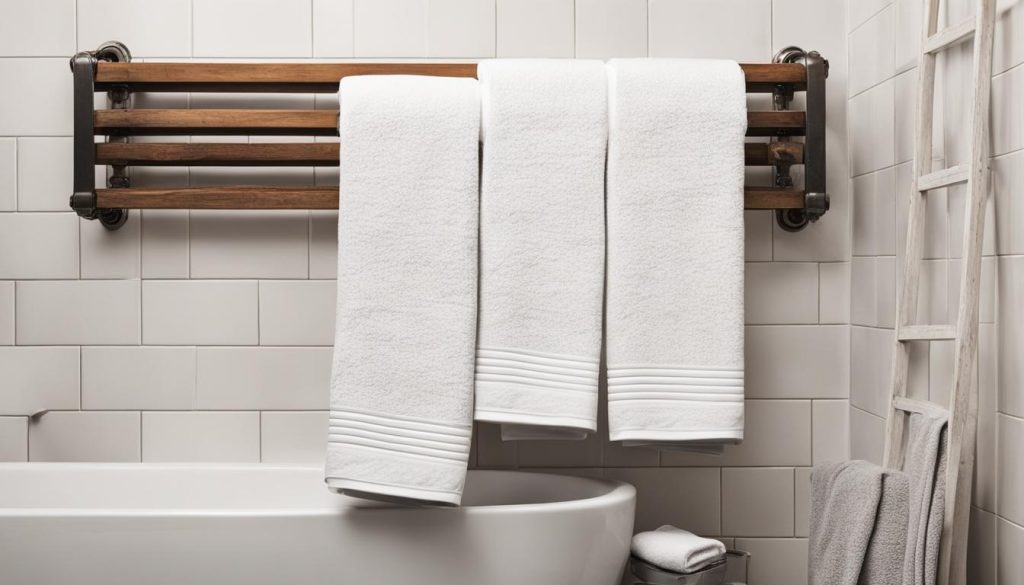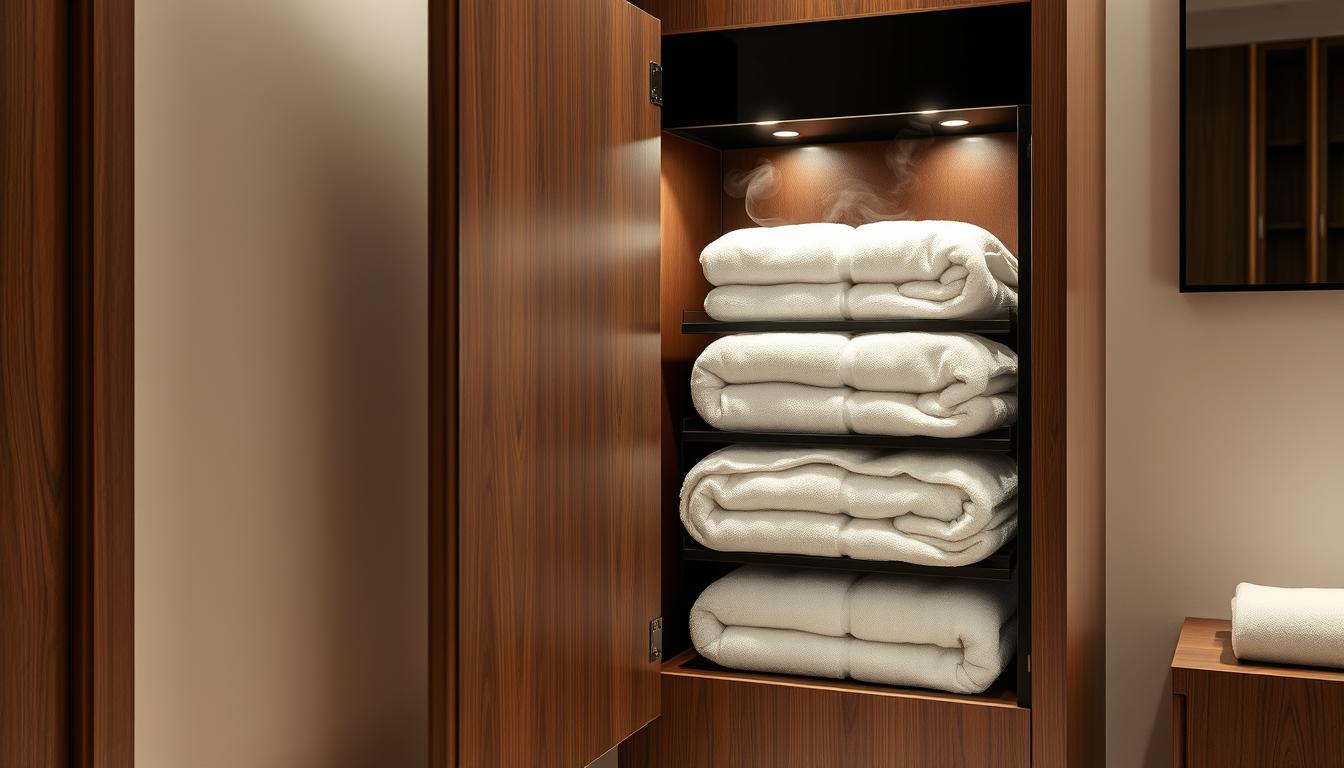A towel warmer can be a luxurious addition to your bathroom, always offering a warm towel after a shower or bath during cold winter months. Instead of purchasing an expensive manufactured version, you can create your own DIY towel warmer at home. There are two main methods for building a towel warmer: using a heating vent in your bathroom or purchasing an inexpensive electric heater.
If your bathroom does not have a heating vent, you will need to purchase an electric heater for your DIY towel warmer. To begin, mark the location for your towel rack a few inches above the heating source. Build a square rack using 1×2-inch lumber and connect the pieces in a ‘U’ shape with wood screws. Cut a 45° bevel on a 36-inch piece of lumber to act as a brace that lifts the rack away from the wall. Apply a stain or varnish to give the wood a finished look and attach the towel rack to the wall using swivel brackets. Place the heat source, whether it’s a heating vent or an electric heater, under the rack. Extend the towel rack when you shower and place your towel over it for a nice and warm towel after your shower.
If your bathroom does not have a heating vent, you can create a DIY towel warmer using an electric heater. Begin by marking the location for your towel rack a few inches above the electric heater. Build a square rack using 1×2-inch lumber and connect the pieces in a ‘U’ shape with wood screws. Cut a 45° bevel on a 36-inch piece of lumber to act as a brace that lifts the rack away from the wall. Apply a stain or varnish to give the wood a finished look and attach the towel rack to the wall using swivel brackets. Place the electric heater under the rack and extend the towel rack when you shower. Place your towel over the rack to enjoy a warm towel after your shower.
Another option for a DIY towel warmer is to create a non-electrical version using a heat pad. These non-electrical heating pads can be made using uncooked rice, wheat, buckwheat hulls, barley, oatmeal, beans, or flax seeds as fillers. You can also add various herbs, spices, and essential oils to create a soothing and fragrant experience. Sew the filler into a fabric pouch and heat it in the microwave for 1 to 3 minutes. Place the warm pouches in a storage container or box, layering them between your towels. This DIY non-electrical towel warmer can provide a cozy and aromatic towel after your shower.
One of the advantages of creating your own DIY towel warmer is the ability to customize it to suit your own needs, style, or budget. You can use different types of wood, such as bamboo or reclaimed lumber, to create a unique towel rack. Additionally, you can add decorative elements like hooks, knobs, or decorative woodwork to enhance the overall look of the towel warmer. Consider painting or staining the wood to match your bathroom decor. Get creative and make your DIY towel warmer truly your own.
Key Takeaways:
- Creating your own DIY towel warmer can save you money compared to purchasing a manufactured version.
- You can build a towel warmer using a heating vent in your bathroom or an inexpensive electric heater.
- If using a heating vent, mark the location for your towel rack and build a square rack to place above the vent.
- If using an electric heater, mark the location for your towel rack and build a square rack to place above the heater.
- Another option is to create a non-electrical towel warmer using a heat pad filled with rice, wheat, or other fillers.
- Customize your DIY towel warmer by using different types of wood, adding decorative elements, and matching it to your bathroom decor.
DIY Towel Warmer with Heating Vent
If your bathroom does not have a heating vent, don’t worry! You can still enjoy the luxury of a warm towel with a DIY towel warmer. In this section, we will guide you through the process of installing a towel warmer using a heating vent.
To begin, mark the location for your towel rack a few inches above the heating source. This will ensure that your towel is heated effectively. Next, gather the following materials:
- 1×2-inch lumber
- Wood screws
- Stain or varnish for finishing
- Swivel brackets for mounting
Using the 1×2-inch lumber, build a square rack and connect the pieces in a ‘U’ shape using wood screws. This will provide a sturdy structure for your towels. To ensure proper mounting, cut a 45° bevel on a 36-inch piece of lumber. This will act as a brace, lifting the rack away from the wall.
Apply a stain or varnish to give the wood a beautiful finished look that complements your bathroom decor. Once the wood is dry, attach the towel rack to the wall using swivel brackets.
“Creating your own DIY towel warmer is a cost-effective way to add a touch of luxury to your bathroom.”
Now comes the installation of the heat source. If you have a heating vent, simply position the rack above it. The warm air from the vent will naturally heat your towels when the rack is extended. If you don’t have a heating vent, you can use an electric heater as an alternative heat source.
Remember to extend the towel rack when you shower and place your towel over it. The heat from the heating vent or electric heater will keep your towel warm and cozy, giving you a spa-like experience right at home.
With this simple DIY towel warmer installation, you can enjoy the luxury of warm towels without breaking the bank. Now, let’s move on to other exciting DIY towel warmer ideas and projects you can try.
DIY Towel Warmer with Electric Heater
If your bathroom doesn’t have a heating vent, don’t worry! You can still enjoy the comfort of a warm towel by creating your own DIY towel warmer using an electric heater. With a few simple steps, you’ll have a cozy and luxurious addition to your bathroom.
Here’s how to install a DIY towel warmer with an electric heater:
- Start by marking the location for your towel rack. Choose a spot a few inches above the electric heater, ensuring it’s easily accessible.
- Next, build a square rack using 1×2-inch lumber. Connect the pieces in a ‘U’ shape using wood screws, creating a sturdy frame for your towels.
- To lift the rack away from the wall, cut a 45° bevel on a 36-inch piece of lumber. This angled brace will provide the necessary support.
- For a polished look, apply a stain or varnish to the wood, giving it a finished appearance.
- Attach the towel rack to the wall using swivel brackets, ensuring it’s securely in place.
- Now, it’s time to position the electric heater. Place it directly below the towel rack, making sure it’s safely away from any flammable materials.
- When you take a shower, extend the towel rack and hang your towel over it. The electric heater will provide gentle heat, warming your towel to perfection.
Enjoy the bliss of a warm towel after each shower with your DIY towel warmer and electric heater combination.
DIY Non-Electrical Towel Warmer
Looking for an alternative to an electric towel warmer? Consider creating your own non-electrical version using a heat pad. This DIY towel warmer project is simple, affordable, and doesn’t require any electrical wiring. Here’s how you can make your own cozy and aromatic towel warmer at home:
Gather Your Materials
- Fabric pouch
- Uncooked rice, wheat, buckwheat hulls, barley, oatmeal, beans, or flax seeds
- Various herbs, spices, and essential oils (optional)
- Microwave
- Storage container or box
Create the Heating Pad
- Sew the fabric pouch to a suitable size, ensuring it is tightly sealed on all sides.
- Fill the pouch with your choice of filler, such as uncooked rice or flax seeds.
- For a soothing and fragrant experience, add herbs, spices, or essential oils to the filler mixture.
Warm and Store Your DIY Towel Warmer
- Place the fabric pouch in the microwave and heat it for 1 to 3 minutes, depending on the desired warmth.
- Insert the warm pouches into a storage container or box.
- Layer your towels between the warm pouches, ensuring they are evenly distributed.
Now you have your own homemade non-electrical towel warmer! The heat pad will provide a cozy and aromatic touch to your towels, making your post-shower experience even more enjoyable. Reheat the pouches as needed to maintain the warmth.
With this DIY towel warmer project, you can save money and create a personalized touch for your bathroom. It’s a great option for those who prefer non-electrical solutions or want to add a unique element to their space.
Remember, safety is important when using any heated objects. Always follow the manufacturer’s instructions or recommended heating times to avoid any accidents or damage.

Customize Your DIY Towel Warmer
When it comes to creating your own DIY towel warmer, the possibilities for customization are endless. This is one of the major advantages of embarking on a towel warmer DIY project – you have the freedom to tailor it to your specific needs, style, and budget.
Start by selecting the type of wood that appeals to you. Opt for a sustainable option like bamboo or give your towel warmer a rustic touch with reclaimed lumber. The choice is yours, and it’s what will make your towel rack truly unique.
To add a personal touch, consider incorporating decorative elements. Hooks, knobs, or decorative woodwork can enhance the overall look of your towel warmer, adding both style and functionality. Think about the design aesthetic you want to achieve and choose elements that complement your bathroom decor.
Finally, don’t forget the finishing touches. Painting or staining the wood can help tie your DIY towel warmer seamlessly into your bathroom decor. Whether you prefer a bold color or a natural wood finish, this is an opportunity to make your creation truly your own.
FAQ
How can I create my own DIY towel warmer at home?
There are two main methods for building a DIY towel warmer: using a heating vent in your bathroom or purchasing an inexpensive electric heater.
What materials do I need to create a DIY towel warmer with a heating vent?
To create a DIY towel warmer with a heating vent, you will need 1×2-inch lumber, wood screws, a 36-inch piece of lumber for a brace, a stain or varnish, swivel brackets, and a heating vent.
How do I create a DIY towel warmer with a heating vent?
Mark the location for your towel rack above the heating source, build a square rack using the lumber and wood screws, cut a 45° bevel on the brace to lift the rack away from the wall, apply a stain or varnish for a finished look, and attach the towel rack to the wall using swivel brackets. Place the heating vent under the rack and extend the towel rack when you shower.
What materials do I need to create a DIY towel warmer with an electric heater?
To create a DIY towel warmer with an electric heater, you will need 1×2-inch lumber, wood screws, a 36-inch piece of lumber for a brace, a stain or varnish, swivel brackets, and an electric heater.
How do I create a DIY towel warmer with an electric heater?
Mark the location for your towel rack above the electric heater, build a square rack using the lumber and wood screws, cut a 45° bevel on the brace to lift the rack away from the wall, apply a stain or varnish for a finished look, and attach the towel rack to the wall using swivel brackets. Place the electric heater under the rack and extend the towel rack when you shower.
Can I create a DIY towel warmer without an electric heater or heating vent?
Yes, you can create a non-electrical version of a DIY towel warmer using a heat pad. You can make the heat pad using fillers like rice, wheat, buckwheat hulls, barley, oatmeal, beans, or flax seeds. Sew the filler into a fabric pouch, heat it in the microwave, and place the warm pouches in a storage container or box between your towels for a cozy experience.
Is it possible to customize my DIY towel warmer?
Absolutely! One of the advantages of creating your own DIY towel warmer is the ability to customize it to suit your needs, style, or budget. You can use different types of wood, add decorative elements like hooks or knobs, and paint or stain the wood to match your bathroom decor.


